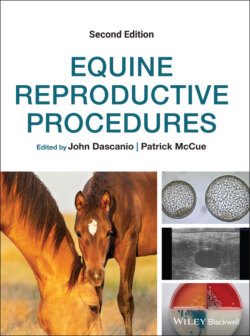Читать книгу Equine Reproductive Procedures - Группа авторов - Страница 97
Оглавление30 Prostaglandin E2 Treatment for Blocked Oviducts
Patrick M. McCue,1 Sofie Sitters2 and Charles F. Scoggin3
1 Equine Reproduction Laboratory, Colorado State University, USA
2 Amsterdam, The Netherlands
3 Rood and Riddle Equine Hospital, USA
Introduction
Studies have reported that oviducts (uterine tubes) of middle aged and older mares may contain gelatinous masses of collagen, fibroblasts, and debris which can occlude the lumen of the oviduct. This may lead to a reduction in fertility by either preventing sperm from reaching the site of fertilization or preventing embryos from reaching the uterus. The frequency with which clinical obstructions occur is unknown. However, clinical studies have reported that topical administration of prostaglandin E2 (PGE2) onto the surface of the oviduct in mares with unexplained fertility has resulted in a resumption in fertility in a high proportion of treated mares.
The technique is performed via laparoscopy and involves direct visualization of the serosal surface of the oviduct, ovary, and their mesenteric attachments. It is performed with standing sedation and local anesthesia.
Equine embryos secrete PGE2 which promotes passage of the embryo through the oviductal isthmus into the uterus. Unfertilized oocytes and non‐viable embryos do not produce PGE2 and are consequently retained at the junction of the ampulla and isthmus. This chapter describes the technique of laparoscopic application of PGE2 onto the oviductal surface.
Equipment and Supplies
Surgical pack including sterile drapes, suture material, and/or stapler; scalpel blade; sterile surgery gloves; sterile plastic embryo transfer pipette and 0.5 ml straw; laparoscopic instrumentation – laparoscope: 57 cm or 30 cm × 10 mm, 30 degrees; light source: 300 W xenon with large diameter light cord; video camera and monitor; insufflator: at least 6 l/min (20 l/min preferred); trocars/cannulas: 7.5 and 11.5 mm diameter × 20 cm long. Endolaparoscopic Babcock atraumatic grasping forceps (45 cm (7.5 inch) long); dinoprostone cervical gel (Prepidil® Gel; Pharmacia and Upjohn/Pfizer, New York, USA); disposable 0.5 ml Cassou gun; 0.5 ml semen straws; 2% lidocaine; antibiotics; non‐steroidal anti‐inflammatory drugs; needles; syringes; surgical scrub; examination gloves.
Technique
The mare is fasted for 24 hours prior to treatment.
The mare is placed in stocks designed to allow access to the flank area.
The paralumbar areas are surgically prepared.
Antibiotics and a non‐steroidal anti‐inflammatory agent are administered prior to surgery; treatment may continue after surgery as needed.
Detomidine hydrochloride (0.01 mg/kg IV) is administered for sedation.
A local anesthetic such as 2% lidocaine hydrochloride is injected under the skin and infiltrated into the abdominal muscles and surface of the peritoneum in the two instrumental portal sites in the paralumbar region. Local anesthesia may also be accomplished with an inverted “L” in the paralumbar fossa.
A 1–2.5 cm (0.5–1 inch) skin incision is made 10–15 cm (4–6 inches) below the dorsal aspect of the tuber coxae.
A trochar and cannula are passed through the skin incision and inserted into the abdominal cavity.
A 10 mm OD rigid laparoscope with a 30‐degree viewing angle is inserted into the peritoneal cavity.
The abdomen is distended by insufflation with CO2 gas to allow for visualization of the ipsilateral ovary, oviduct, and uterine horn.
A second (7.5 mm OD) trochar and cannula are passed into the abdominal cavity 5–10 cm (2–4 inches) dorsal to the laparoscope.
Atraumatic forceps are used to grasp and manipulate the ovary and expose the full length of the oviduct.
The forceps are removed and replaced with a sterile disposable embryo transfer gun containing a 0.5 ml straw loaded with PGE2 gel.
The gel is slowly extruded onto the surface of the oviduct from the infundibulum to the utero‐tubular junction, but especially along the isthmus region (Figure 30.1).
The application is repeated using a second disposable embryo transfer gun yielding a total dosage of 1.0 ml (0.2 mg) of PGE2 gel on one oviduct.
The procedure is subsequently performed on the contralateral oviduct.
The CO2 gas is released from the abdomen and all cannulas are removed and the skin incisions are closed with sutures or staples.
Additional Comments
The procedure has been successfully performed in mares in behavioral estrus and in mares in diestrus. In the original study by Allen et al. (2006), 14 of 15 mares (93%) treated with PGE2 conceived to matings in either the same or subsequent breeding season after having previously been barren for multiple seasons for unknown reasons. In a report by Ortis et al. (2013), embryos were recovered or pregnancies were obtained from 24 of 28 barren mares treated with topical PGE2.
Figure 30.1 Application of PGE2 gel (small arrow) onto surface of the oviduct (large arrow).
Proper selection of candidate mares is one of the most important considerations for potential PGE2 treatment. Blockage of the oviduct(s) should be considered as a cause for infertility in a mare that has historically produced live foals if all other common causes of infertility are evaluated first and addressed.
References
1 Allen WR, Wilsher S, Morris L, et al. 2006a. Laparoscopic application of PGE2 to re‐establish oviductal patency and fertility in infertile mares: a preliminary study. Eq Vet J 38: 454–9.
2 Ortis HA, Foss RR, McCue PM, Bradecamp EA, Ferris RA, Hendrickson DA. 2013. Laparoscopic application of PGE2 to the uterine tube surface enhances fertility in selected subfertile mares. J Eq Vet Sci 33(11): 896–900.
Further Reading
1 Allen WR, Wilsher S, Morris L, et al. 2006b. Re‐establishment of oviductal patency and fertility in infertile mares. Anim Reprod Sci 94: 242–3.
2 Robinson SJ, Neal H, Allen WR. 2000. Modulation of oviductal transport in mares by local application of prostaglandin E2. J Reprod Fertil 56:587–92.
3 Weber JA, Freeman DA, Vanderwall DK, Woods GL. 1991. Prostaglandin E2 secretion by oviductal transport‐stage equine embryos. Biol Reprod 45: 540–3.
